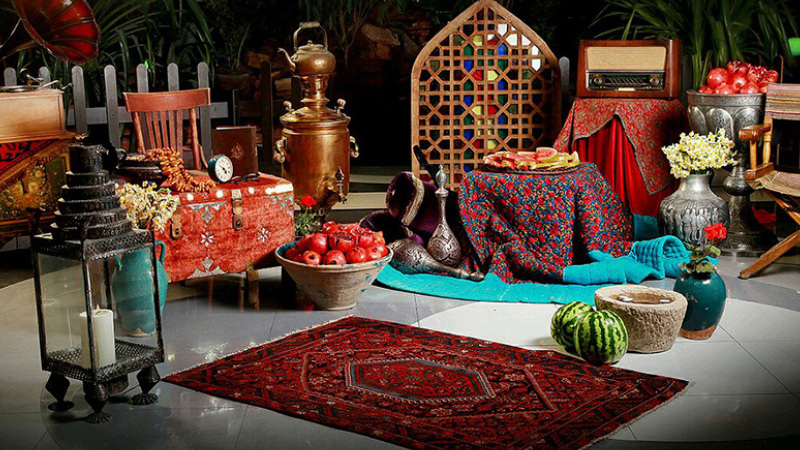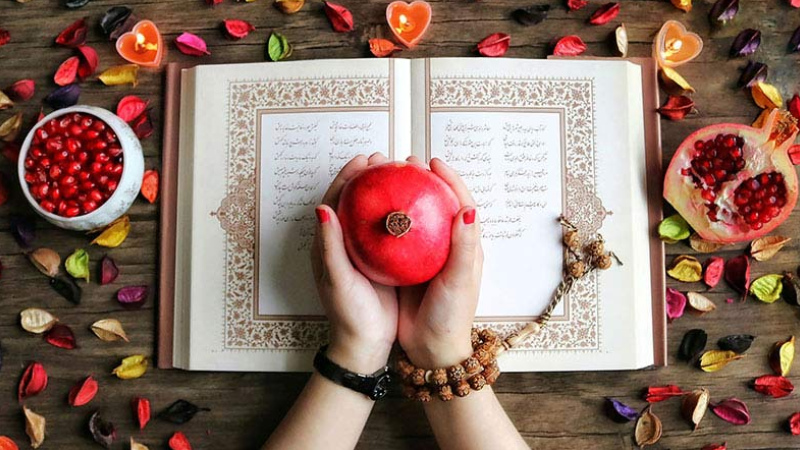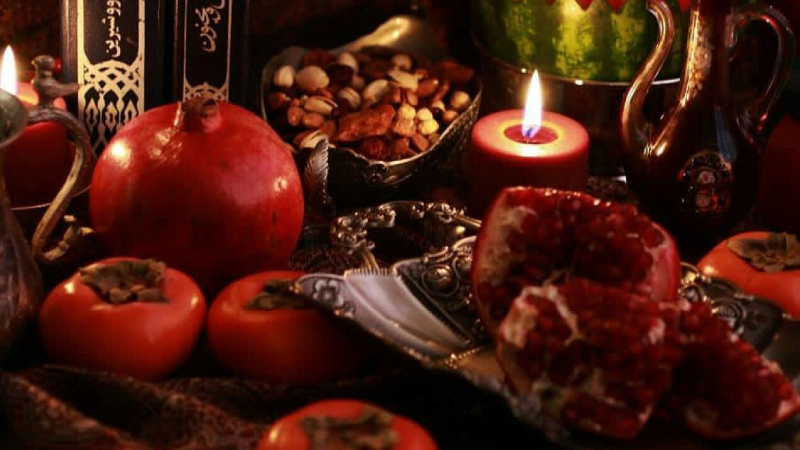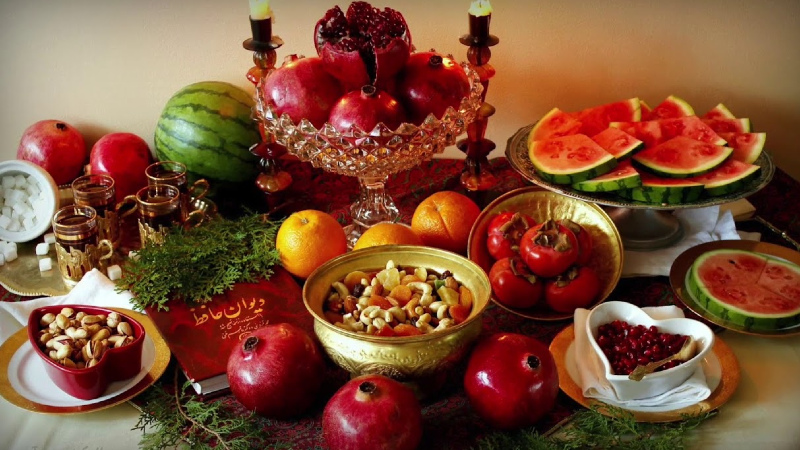Yalda night is one of the oldest celebrations and ceremonies in Iran. This night starts from sunset on 30 Azar (December 20 or December 21) and continues until sunrise on 1 Dey (December 21 or December 22). On this night, Iranian families celebrate together and serve an elaborate dinner. In Yalda, various fruits such as bananas, pomegranates, apples, oranges and watermelons are consumed along with various snacks. Hafez Fortunes, reciting the Shahnameh and telling stories by the elders of the family are among Yalda customs in Iranian culture.

The history of Yalda night
Yaldā Night ritual (Persian: شب یلدا; shab-e yalda) or Chelle Night (Persian: شب چله; shab-e chelle) is one of the oldest celebrations of Iranians. The exact history of this celebration is not known, but according to the designs on the pottery prepared by hand in archaeological excavations, this celebration probably dates back to more than 7,000 years ago. From 502 BC and during the time of Darius I son of Hystaspes, shab-e yalda was officially entered into the calendar of ancient Iranians. At that time, most people were farmers.
As the seasons change, they realized that the last day of autumn and the first night of winter is the longest night of the year, and after that, the days gradually get longer and the nights get shorter. This issue was an excuse to celebrate this night. In Avesta and Zoroastrian culture, this night is sacred and signifies the beginning of the year and Ahura Mazda’s victory over Ahriman, promising happiness and victory.
According to the narrations, this night also means the birth of the sun god and Mithra (Mithra or Mehr, one of the gods of the ancient Iranians, who is also known as the god of oath, justice, sun, light and covenant.). In this night he returns and by lengthening the daylight hours, it causes more sunlight to reach the earth. Yalda night is similar to Thanksgiving and Christmas, and on this night, Iranian families celebrate the end of autumn and the beginning of winter.
Yalda night traditions
This night is a special and important night in Iranian culture and they celebrate it. Various traditions are performed on this night, some of which are the same for all Iranians, and others are different in each city.
Building a fire
In ancient Iranian culture, fire and heat are sacred and are known as a force to ward off demonic forces. From ancient times until today, Iranian families gather around a fire or a heat source on shab-e yalda to celebrate with each other. In the past, a kind of wooden table called Korsi was used on Yalda night. Under this table, there is a heater and some blankets are thrown on it and people can sit around this table and get warm.
Reading the Shahnameh
Shahnameh is one of the most valuable books in Iranian literature. The stories and poems of this book narrate the courage, sacrifice and values of ancient Iranians, and for this reason, Shahnameh is very popular among Iranians. Reading Shahnameh or Naqqāli (Persian: Naqali) is one of the customs of Yalda night. Naqali is an Iranian dramatic storytelling method and in it, a person reads the epic stories and poems of the Shahnameh in a dramatic way and with great excitement.

Hafez Fortunes
Reading Hafez’s poems is one of the old traditions of the people on Yalda night. On this night, fortune is taken by one of the elderly members of the family with Divan Hafez. According to the belief of Iranians, any poem that is chosen for a person asking for fortune-telling, determines his fate in the goal he had in mind. Hafez Fortunes is one of the most popular things among Iranians who do it in various celebrations or parties.
Storytelling by family elders
Many of us have heard beautiful stories from our grandparents or parents when we were children. Stories that were either true or based on different legends. Storytelling is another tradition of shab-e yalda. In this tradition, the younger members of the family sit next to the grandparents and listen to the stories they tell.
Eating different fruits and snacks
On Yalda night, various foods are served. These foods are different based on each Iranian city and can include snacks, different fruits, nuts and sweets. Pomegranate and watermelon are two very popular fruits among Iranians that are used on shab-e yalda. Among Iranians, pomegranate is a symbol of fertility and watermelon is also a symbol of summer heat and sunlight. Besides these two fruits, other fruits such as apples, oranges, tangerines and persimmons are also eaten on this night.
Yalda night snacks are very diverse and can include nuts such as pistachios, almonds, walnuts, hazelnuts, seeds, raisins, roasted chickpeas, roasted rice, roasted wheat and even dried fruits such as apple leaves, peaches, cantaloupe, bananas and mango.

Yalda night traditions in different cities of Iran
shab-e yalda is a national celebration among Iranians and they celebrate this night in all the cities and villages of Iran. The main traditions of this night are almost the same throughout Iran, but each city or village also has special customs for Yalda.
Esfahan
In different cities of Isfahan province, in addition to the main customs of Yalda night and special fruits and snacks of this city, local dishes such as Kofte and Sabzi Polo ba Mahi are also served. If a girl is newly married, the groom’s family sends her various gifts on this night. These gifts usually include decorated fruits, fabrics with warm colors such as red, orange and yellow, gold, bags, shoes and winter clothes.
Khorasan
In North Khorasan, Razavi Khorasan and South Khorasan provinces, Yalda night is celebrated with local snacks. These snacks include a type of local sweet called Kaf. This sweet is prepared from the root extract of a plant called Chubak, and its color is white and it resembles pizza cheese. In addition to these sweets, boiled turnips and beets are also served on shab-e yalda in these 3 provinces.
Lorestan
Yalda night in different cities of Lorestan province is a bit like Halloween. One of the customs of the people of this province on shab-e yalda is to give sweets, chocolates and nuts to children. On this night, children go to the roofs of the houses and hang a cloth from the roof while singing local songs. Neighbors also bring nuts and sweets to the children and throw them in the hanging cloth.
Hamedan
In this province, a ritual called Fal’ Suzan (A kind of divination done with a needle) is performed on Yalda night. To do this divination, family members sit around the room and an old woman recites poems while a little girl sticks a needle into an unsewn and uncut piece of cloth. Every time the girl stops needle the cloth, each poem the old woman reads means a person’s fortune. The order of people’s seating and the order of the poems read by the old woman determines the fortune of each person.
Conclusion
Yalda is one of the most beautiful rituals of Iranians, whose main purpose is to be happy and celebrate with the family. On this night, Iranians spend the darkest moments of the year with their families and see light with the sunrise. Various rituals include Hafez Fortunes, reciting the Shahnameh, feasting next to the Korsi or a heat source, storytelling by the elders of the family, giving sweets and chocolates to the children and giving various gifts to the new members of the family on this night.

